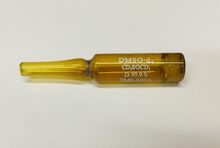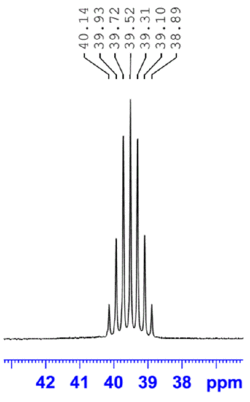Chemistry:Deuterated DMSO

| |

| |
| Names | |
|---|---|
| Preferred IUPAC name
[(2H3)Methanesulfinyl](2H3)methane | |
| Other names
Deuterated dimethyl sulfoxide, DMSO-d6
| |
| Identifiers | |
3D model (JSmol)
|
|
| Abbreviations | DMSO-d6 |
| 1237248 | |
| ChemSpider |
|
| EC Number |
|
PubChem CID
|
|
| RTECS number |
|
| |
| |
| Properties | |
| C2D6OS | |
| Molar mass | 84.17 g/mol |
| Density | 1.19 g/cm3 (20 °C) |
| Melting point | 20.2 °C (68.4 °F; 293.3 K) |
Except where otherwise noted, data are given for materials in their standard state (at 25 °C [77 °F], 100 kPa). | |
| Infobox references | |
Deuterated DMSO, also known as dimethyl sulfoxide-d6, is an isotopologue of dimethyl sulfoxide (DMSO, (CH3)2S=O)) with chemical formula ((CD3)2S=O) in which the hydrogen atoms ("H") are replaced with their isotope deuterium ("D"). Deuterated DMSO is a common solvent used in NMR spectroscopy.
Production
Deuterated DMSO is produced by heating DMSO in heavy water (D2O) with a basic catalyst such as calcium oxide. The reaction does not give complete conversion to the d6 product, and the water produced must be removed and replaced with D2O several times to drive the equilibrium to the fully deuterated product.[1]
Use in NMR spectroscopy
Pure deuterated DMSO shows no peaks in 1H NMR spectroscopy and as a result is commonly used as an NMR solvent.[2] However commercially available samples are not 100% pure and a residual DMSO-d5 1H NMR signal is observed at 2.50ppm (quintet, JHD=1.9Hz). The 13C chemical shift of DMSO-d6 is 39.52ppm (septet).[3]
References
- ↑ & Hampel, Bruno"Process for the production of hexadeuterodimethyl sulfoxide" DE patent application 1171422B, published 1964-06-04, assigned to E. Merck A.G.
- ↑ Chandak, MS; Nakamura, T; Takenaka, T; Chaudhuri, TK; Yagi-Utsumi, M; Chen, J; Kuwajima, K (2013). "The use of spin desalting columns in DMSO-quenched H/D-exchange NMR experiments". Protein Sci 22 (4): 486–91. doi:10.1002/pro.2221. PMID 23339068. PMC 3610054. https://onlinelibrary.wiley.com/doi/10.1002/pro.2221. Retrieved 11 Feb 2013.
- ↑ Gottlieb, Hugo E.; Kotlyar, Vadim; Nudelman, Abraham (1997). "NMR Chemical Shifts of Common Laboratory Solvents as Trace Impurities". The Journal of Organic Chemistry 62 (21): 7512–7515. doi:10.1021/jo971176v. PMID 11671879. https://pubs.acs.org/doi/full/10.1021/jo971176v. Retrieved 18 June 2011.
 |


